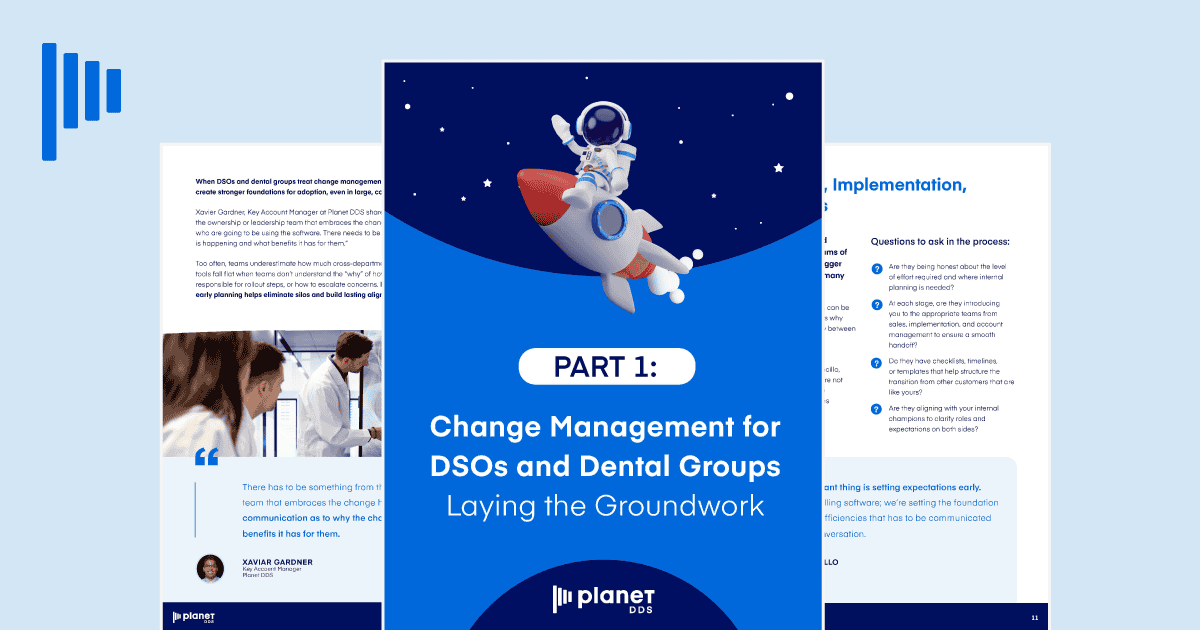Change Management for DSOs and Dental Groups: Laying the Groundwork

Adopting new dental technology is a major investment, but the real return depends on how prepared your organization is before implementation even begins. For DSOs and dental groups, the earliest phase of a platform transition is where the most impactful work happens. Before onboarding starts, teams need alignment, leaders need clarity, and the organization needs a shared understanding of what’s changing and why.
Change management requires setting expectations, defining responsibilities, and preparing every part of the organization to work toward the same goal. Part 1: Change Management for DSOs and Dental Groups—Laying the Groundwork explores the pre-implementation phase and what DSOs and dental groups can do now to create the structure and unity needed for lasting success.
What Change Management Really Means for DSOs
In dental organizations, change often comes in the form of a new system or software. But what really needs to change is how teams think, communicate, and work. This makes change management a strategic effort, not just a technical one.
What to include before you get started:
- A shared understanding of how new systems will affect clinical, operational, and IT teams
- Leadership support that goes beyond approvals and includes direct involvement
- Clear alignment between departments about roles, responsibilities, and timelines
- Internal planning that begins before onboarding
“There has to be something from the ownership or leadership team that embraces the change head-on. There needs to be communication as to why the change is happening and what benefits it has for them.” —Xavier Gardner, Key Account Manager, Planet DDS
How Organizations Evaluate Change Readiness
The signs of a well-prepared organization show up in how teams talk about the change, whether leadership is aligned, and how much structure exists before implementation begins.
The signs your DSO is ready (or not):
- Ownership is clearly assigned, and team members know who to turn to for updates
- Workflows are documented and communicated across departments
- Employees are informed early on and initial concerns addressed
- Internal planning includes more than just IT or project managers
“When organizations take the time to assess readiness, they discover gaps early that would otherwise become major issues later.” —Xavier Gardner, Key Account Manager, Planet DDS
Common Pain Points Before Implementation Begins
Many of the challenges that surface during implementation start earlier, when planning is rushed, responsibilities unclear, or communication doesn’t reach the right people.
What to watch out for:
- Misalignment between operations, IT, and clinical teams
- Conflicting expectations about timelines or resources
- Limited communication about why change is happening
- Frustration from team members not included in early discussions
“Change management is difficult in our industry, because most users have been using the same software for a long time. There’s nervousness and anxiety that comes when they hear they are moving to new software.” —Xavier Gardner, Key Account Manager, Planet DDS
Misconceptions That Undermine Change
One of the most overlooked barriers to adoption is how teams think about change in the first place. Assumptions about what a transition will involve can set the stage for confusion or delay.
Common misconceptions include:
- Believing the transition is a simple software update
- Assuming prior experience with other systems will make this transition easier
- Expecting the provider to manage all aspects of the rollout
- Relying on training alone to drive adoption
Resetting expectations is a leadership task. Each transition is unique, especially in multi-location organizations, and preparing teams with realistic expectations creates smoother adoption.
“Every transition is unique. What worked during a previous change may not apply here, particularly when cloud-based platforms or multi-location considerations are involved.” —Xavier Gardner, Key Account Manager, Planet DDS
Aligning Leadership and Ownership Before Change Begins
Technology transitions require leadership, not just buy-in. Success depends on whether the right people are involved and responsibilities clearly defined.
Key actions for leadership teams:
- Assign ownership across operations and IT.
- Identify a respected internal champion to advocate for change.
- Align leadership on communication strategy and timing.
- Address resistance points before rollout.
“The most successful clients have their own ‘secret sauce’ in terms of what they do with enablement, what modules they use, and how they use them. But it starts with leadership buy-in and a clear plan.” —Xavier Gardner, Key Account Manager, Planet DDS
Roles of Sales, Implementation, and AM Teams
The provider’s sales, implementation, and account management (AM) teams play a bigger role in readiness than many organizations realize. From the first call, expectations should be set in ways that prepare internal teams.
Get answers to:
- Why early collaboration with vendors matters
- What questions to ask during sales and handoff stages
- How DSOs benefit from aligned expectations between internal and external teams
“The most important thing is setting expectations early. We’re not just selling software; we’re setting the foundation for growth and efficiencies that has to be communicated from the first conversation.” —Carlos Vallecillo, Director of Sales, Planet DDS
Setting the Tone for a Successful Transition
The clearest insights about readiness often surface before implementation begins. Asking questions early helps reduce friction later.
Concerns to address early:
- Disruptions to clinical operations
- Assignment of responsibilities
- Managing staff concerns about workflows
- Clarity on what the vendor owns versus what the DSO owns
“The best transitions happen when we’re aligned with the internal project owner early. That’s the person who can keep things moving and make sure everyone internally is on the same page.” —John Adams, Account Executive, Planet DDS
Resources That Lay the Groundwork for Success
A well-prepared organization rarely starts from scratch. The right tools and planning resources help DSOs organize and build consensus before onboarding.
Tools to consider:
- Stakeholder alignment maps and readiness assessments
- Change management plan templates with milestones
- Internal kickoff agendas to prepare before the vendor kickoff
- Recommendations for outside consultants when needed
“For smaller or mid-sized groups that don’t have the same type of infrastructure, it’s important to build that infrastructure sooner rather than later. Otherwise, they end up struggling when one person leaves.” —Sara Ettinger, Key Account Manager, Planet DDS
Strategies for Smoother Transitions
Successful transitions share common traits: thoughtful planning, clear ownership, and an emphasis on adoption.
Tips that work for organizations:
- Begin cross-functional planning before a final platform decision.
- Define success beyond go-live, including adoption.
- Create checkpoints for departments to share concerns.
- Build a shared vocabulary for rollout.
“It’s not usually the technical parts that break down a rollout. It’s usually because someone on the team is struggling, or they didn’t get the right support, or the organization didn’t prepare them for it. It’s always the human side.” —Sara Ettinger, Key Account Manager, Planet DDS
Get Prepared for Change Now
Adoption starts long before implementation. The organizations that see the strongest results are those that plan early, align leadership, and keep the “why” visible throughout the process. By treating change management as a core strategy, DSOs and dental groups reduce disruption and create momentum from day one.
Looking for strategies to strengthen implementation and support teams after launch? Check out: Part 2: Change Management for DSOs and Dental Groups: Leading Teams Through Transition
Ready to strengthen your change management strategy? Contact us today.



